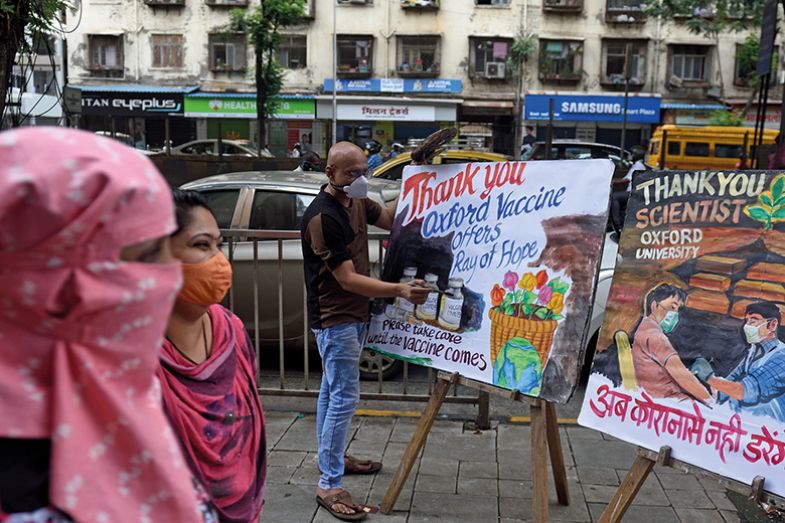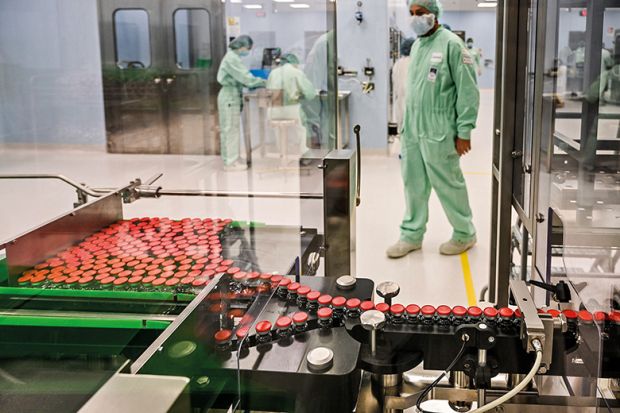Browse the full results of the World University Rankings 2022
Download a copy of the World University Rankings 2022 report
It’s arguably the most significant university-industry collaboration of the 21st century.
By the end of the year, 3 billion doses of the Oxford/AstraZeneca coronavirus vaccine, a joint effort by the University of Oxford and the British-Swedish pharmaceutical giant, should have been delivered globally.
The jab has had its fair share of bad publicity. Missed deliveries enraged the European Union in the spring, while extremely rare blood clots have left it unapproved for younger people in some countries.
But it remains the (still largely unvaccinated) developing world’s great hope, being relatively easy to store and costing vastly less per shot than its rivals – partly thanks to an agreement between Oxford and AstraZeneca not to make a profit on the jab until after the pandemic is deemed over.
Yet Louise Richardson, the University of Oxford’s vice-chancellor, worries that despite success this time round, come the next pandemic, no pharmaceutical company will be willing to take a similar risk.
“There’s no incentives in the future for a company to do what AstraZeneca has done,” she warns Times Higher Education. “They’ve taken a great risk, and they’re forgoing profits. They haven’t gotten the recognition that I think they deserve.”
Meanwhile, other vaccine manufacturers have made a “fortune”, she says. “We’ve created these perverse incentives for the future.”
The deal between Oxford and AstraZeneca almost didn’t happen. As early as January 2020, scientists at Oxford’s Jenner Institute were working on a vaccine platform they thought might tackle the mysterious new disease spreading in China. Operating on a “shoestring”, Oxford underwrote their exploratory work with £1 million, recalls Richardson.
“There was huge uncertainty at this stage, but they still felt that there was a real chance they might be on to something,” she says. “To be perfectly honest, we didn’t have a long queue of companies” willing to collaborate.
Some reports have suggested that Oxford scientists rejected a tie-up with US pharmaceutical giant Merck on the grounds that they wouldn’t distribute the vaccine equitably across the world at cost.
“The fact that AstraZeneca was a British company was a plus from our point of view,” says Richardson. “Remember that…we had a very erratic and very jingoistic president in the US.”
“I had some concern about that. If we were to deal with an American company, did we run the risk that if something worked you might have Trump intervene, which was another plus for AstraZeneca,” she adds.
Manuel Martin, innovation and access policy adviser at Médecins Sans Frontières (MSF), is generally complimentary about how Oxford has used its leverage to make sure AstraZeneca committed to not making a profit on the vaccine, at least while it defines the pandemic as ongoing.
“It is undoubtedly the cheapest, or among the cheapest, vaccine,” he says.
Not only that, the company has been liberal in allowing “semi-independent production” of the vaccine by other manufacturers in Brazil and India to hasten access in poorer countries, he adds.
Martin praises Oxford for shopping around among manufacturers to make sure developing countries would gain access. “Selecting the right partner as a research university is enormously important,” he says.
But the exact details of the deal between Oxford and AstraZeneca, covering key terms such as who will profit from royalties and when, are still secret, he notes, making it “very hard” to truly assess how good a deal it was.
A private “commercial document” is “standard practice in business”, counters Richardson.

Another university that played an important, if less publicised, role in developing vaccines is Leiden University Medical Center (LUMC) in the Netherlands. For decades it had been a centre of coronavirus research, and it spun out a company that would eventually become Janssen, the firm that would develop a one-shot vaccine under the umbrella of its US-based parent company, Johnson & Johnson.
With LUMC and Janssen close neighbours and already working together on other projects, as the pandemic began to take hold in the spring of 2020, the company approached the university to test several vaccine candidates in LUMC’s high-security labs. Unlike Oxford, LUMC didn’t design the vaccine itself, but tested whether it created neutralising antibodies against the virus.
LUMC is discussing whether and on what terms to renew its two-year testing contract with Janssen, says Marjolein Kikkert, an associate professor in LUMC’s Center for Infectious Diseases.
“It’s nice money,” she says. However, “the bottom line is that we are more looking for an interaction as Oxford had with AstraZeneca,” she explains. “So, as an academic group, we would be more interested in being involved more directly in the innovation itself, and help providing the scientific knowledge needed.”
After the experience of the pandemic, universities and pharmaceutical companies want to take more of the entire vaccine-creation process in-house, she says. “More and more academic groups at hospitals and universities are looking for ways of expanding their possibilities for really getting into the development of medicine and vaccines.”
Research groups want to go “beyond just the ideas”, she says, and move into producing the vaccines, and running clinical trials, themselves “in order to make these medicines in much cheaper ways than companies can. That’s a development that’s going on here at LUMC as well.”
For MSF’s Martin, the dream is a system where research universities have such well-developed research, early stage manufacturing and testing capabilities that they can create vaccines and medicines that are openly available for any manufacturer in the world to produce and distribute, ending a patent-protected system of monopoly pricing.
“That’s a trend that we are beginning to see,” he says. “Universities have realised that they can go further, and they are not just limited to the very early stage pre-clinical research.”
Because Oxford was able to conduct so much of the development process – designing the vaccine and jointly conducting clinical trials – it was able to leverage a much better deal in terms of global public health, he says. “Why can’t other universities do that themselves?” he asks. “The further downstream [in the vaccine-creation process] you go, the more leverage you have over how vaccines are shared and produced.”
“In an ideal world”, Oxford “will have bigger trials” and “will have bigger manufacturing facilities”, says Richardson.
But she is cautious about trying to capture an even bigger slice of the vaccine-creation process. “We’re a university, first and foremost,” she says. “We don’t want to turn ourselves into a pharma company.”
Oxford did contemplate simply giving away the vaccine formula, as advocated by MSF. “We did consider: what if we just put it out there and let anybody who wants to around the world manufacture it?” Richardson recalls.
But the university feared being held liable for any resultant problems. “We wouldn’t be able to control who was manufacturing it around the world,” she says, and Oxford concluded it was a “safer option” to have a relationship with an established manufacturer.
The deal was struck under “massive uncertainty” and “massive time pressure”, she says, and only came together because a “very small, very senior-level team in AstraZeneca and the university…hammered out all the big points” – meaning it is essential that universities build relationships with potential collaborators before a crisis hits.
“I hope it will be an example for others of what can be achieved,” Richardson says, “ideally in less pressured circumstances.”
Industry pillar
|
Pillar rank |
World University Rankings position |
Institution |
Country/region |
Pillar score |
|
=1 |
53 |
Wageningen University & Research |
Netherlands |
100.0 |
|
=1 |
32 |
Germany |
100.0 |
|
|
=1 |
=16 |
China |
100.0 |
|
|
=1 |
38 |
Germany |
100.0 |
|
|
=1 |
251–300 |
South Africa |
100.0 |
|
|
=1 |
84 |
China |
100.0 |
|
|
=1 |
=99 |
South Korea |
100.0 |
|
|
=1 |
=75 |
China |
100.0 |
|
|
=1 |
501–600 |
Taiwan |
100.0 |
|
|
=1 |
351–400 |
United Arab Emirates |
100.0 |
|
|
=1 |
401–500 |
Russian Federation |
100.0 |
|
|
=1 |
801–1,000 |
Pontifical Catholic University of Rio de Janeiro (PUC-Rio) |
Brazil |
100.0 |
|
=1 |
601–800 |
Turkey |
100.0 |
|
|
=1 |
601–800 |
Taiwan |
100.0 |
|
|
=15 |
103 |
Switzerland |
99.9 |
|
|
=15 |
201–250 |
Netherlands |
99.9 |
|
|
=15 |
201–250 |
Russian Federation |
99.9 |
|
|
=15 |
601–800 |
China |
99.9 |
|
|
=15 |
801–1,000 |
Malaysia |
99.9 |
|
|
=15 |
1,001+ |
Turkey |
99.9 |
|
|
21 |
601–800 |
Turkey |
99.8 |
|
|
22 |
351–400 |
Belgium |
99.6 |
|
|
23 |
=122 |
South Korea |
99.4 |
|
|
24 |
=158 |
Russian Federation |
99.3 |
|
|
=25 |
=42 |
Belgium |
99.2 |
|
|
=25 |
801–1,000 |
China |
99.2 |
|
|
27 |
501–600 |
Turkey |
99.1 |
|
|
28 |
23 |
United States |
99.0 |
|
|
29 |
301–350 |
China |
98.8 |
|
|
30 |
=108 |
Germany |
98.7 |
|
|
31 |
=80 |
Canada |
98.3 |
|
|
32 |
=54 |
South Korea |
98.2 |
|
|
=33 |
=185 |
Pohang University of Science and Technology (POSTECH) |
South Korea |
98.0 |
|
=33 |
1,001+ |
Taiwan |
98.0 |
|
|
35 |
351–400 |
Japan |
97.9 |
|
|
36 |
=75 |
Netherlands |
97.7 |
|
|
=37 |
501–600 |
China |
97.5 |
|
|
=37 |
1,001+ |
Indonesia |
97.5 |
|
|
39 |
=172 |
Germany |
97.4 |
|
|
=40 |
=108 |
Germany |
97.2 |
|
|
=40 |
201–250 |
Japan |
97.2 |
|
|
=42 |
201–250 |
Taiwan |
96.9 |
|
|
=42 |
139 |
Germany |
96.9 |
|
|
=42 |
=151 |
South Korea |
96.9 |
|
|
45 |
34 |
United States |
96.6 |
|
|
=46 |
301–350 |
China |
96.0 |
|
|
=46 |
601–800 |
Russian Federation |
96.0 |
|
|
=48 |
351–400 |
France |
95.8 |
|
|
=48 |
501–600 |
China |
95.8 |
|
|
50 |
301–350 |
Taiwan |
95.7 |
The Times Higher Education World University Rankings 2022, which includes a metric on universities’ industry income, will be published at 00:01 BST on 2 September. The results will be exclusively revealed at the THE World Academic Summit (1-3 September), which will focus on the interrelationship between universities and the places in which they are located.
POSTSCRIPT:
Print headline: An injection of enterprise
Register to continue
Why register?
- Registration is free and only takes a moment
- Once registered, you can read 3 articles a month
- Sign up for our newsletter
Subscribe
Or subscribe for unlimited access to:
- Unlimited access to news, views, insights & reviews
- Digital editions
- Digital access to THE’s university and college rankings analysis
Already registered or a current subscriber? Login










